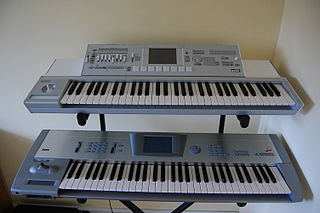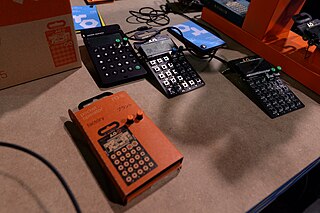
The Roland SH-101 is an analog synthesizer manufactured by the Roland Corporation between 1982 and 1986. Though it was something of a commercial failure during the time of its manufacture, it later became a staple of electronic music in the 1990s, particularly house music.

Novation Digital Music Systems Ltd. is a British musical equipment manufacturer, founded in 1992 by Ian Jannaway and Mark Thompson as Novation Electronic Music Systems. Today the company specializes in MIDI controllers with and without keyboards, both analog and virtual analog performance synthesizers, grid-based performance controllers, and audio interfaces. At present, Novation products are primarily manufactured in China.

The Korg Triton is a music workstation synthesizer, featuring digital sampling and sequencing, released in 1999. It uses Korg's HI Synthesis tone generator and was eventually available in several model variants with numerous upgrade options. The Triton became renowned as a benchmark of keyboard technology, and has been widely featured in music videos and live concerts. At the NAMM 2007, Korg announced the Korg M3 as its successor.

Behringer is an audio equipment company founded by the Swiss engineer Uli Behringer on 25 January 1989, in Willich, Germany. Behringer is known for producing a wide variety of synthesizers, mixers, audio interfaces, and amplifiers, along with various recording and performance accessories.

The Jupiter-8, or JP-8, is an eight-voice polyphonic analog subtractive synthesizer introduced by Roland Corporation in early 1981.

The ARP Odyssey is an analog synthesizer introduced by ARP Instruments in 1972.

The ARP 2600 is a subtractive synthesizer first produced by ARP Instruments, Inc in 1971.

The Korg MS-20 is a patchable semi-modular monophonic analog synthesizer which Korg released in 1978 and which was in production until 1983. It was part of Korg's MS series of instruments, which also included the single oscillator MS-10, the keyboardless MS-50 module, the SQ-10 sequencer, and the VC-10 Vocoder. Additional devices included the MS-01 Foot Controller, MS-02 Interface, MS-03 Signal Processor, and MS-04 Modulation Pedal.

The RolandJuno-60 is an analog synthesizer manufactured by the Roland Corporation between 1982 and 1984. It followed the Juno-6, an almost identical synthesizer released months earlier. The Juno synthesizers introduced Roland's digitally controlled oscillators, allowing for greatly improved tuning stability over its competitors.
Arturia is a French electronics company founded in 1999 and based in Grenoble, France. The company designs and manufactures audio interfaces and electronic musical instruments, including software synthesizers, drum machines, analog synthesizers, digital synthesizers, MIDI controllers, sequencers, and mobile apps.

The Prophet-5 is an analog synthesizer manufactured by the American company Sequential. It was designed by Dave Smith and John Bowen in 1977, who used microprocessors, then a new technology, to create the first polyphonic synthesizer with fully programmable memory. This allowed users to store sounds and recall them instantly rather than having to reprogram them manually; whereas synthesizers had once created unpredictable sounds, the Prophet-5 moved synthesizers to producing "a standard package of familiar sounds".
M-Audio is a business unit of inMusic Brands that designs and markets audio and MIDI interfaces, keyboards and MIDI controllers, synthesizers, loudspeakers, studio monitors, digital DJ systems, microphones, and music software. The company has independent offices in the US, Canada, UK, Germany, France and Japan.
Electronic Dream Plant (EDP) was a small British synthesizer manufacturer, active during the late 1970s and early 1980s. At the time their products were not particularly successful commercially. In later years products like the "WASP" became prized by collectors for their unique sound, and later synthesizer companies have successfully copied some of their design elements.

A synthesizer is an electronic musical instrument that generates audio signals. Synthesizers typically create sounds by generating waveforms through methods including subtractive synthesis, additive synthesis and frequency modulation synthesis. These sounds may be altered by components such as filters, which cut or boost frequencies; envelopes, which control articulation, or how notes begin and end; and low-frequency oscillators, which modulate parameters such as pitch, volume, or filter characteristics affecting timbre. Synthesizers are typically played with keyboards or controlled by sequencers, software or other instruments, and may be synchronized to other equipment via MIDI.
PreSonus Audio Electronics, Inc. is an American manufacturer of professional audio equipment and software, used to create, record, mix, and master music and other audio. This includes their line of digital audio workstation (DAW) software, Studio One. In November 2021, it was announced that the company is to be acquired by Fender.
Monotron is the collective name of a series of miniature analogue synthesizers produced by Korg, a Japanese manufacturer of electronic musical instruments. There are three models in the series: the original Monotron, the Monotron Duo and the Monotron Delay.

The Korg Minilogue is a two VCO per-voice, four-voice, polyphonic analog synthesizer from Korg, designed by Korg engineer and synthesizer designer Tatsuya Takahashi. It was announced just prior to NAMM 2016, and is priced new at $499.99 in the United States, ¥55,000 in Japan and £449 in the United Kingdom and Europe. Its official release was preceded by leaks which caused media speculation.

The Grandmother is an analog semi modular, 32 key synthesizer released by Moog Music Inc. incorporating circuits based on the Moog modular synthesizer Model 15, and the Minimoog.

Pocket Operators are a line of miniature synthesizers, drum machines and grooveboxes, produced by the Swedish manufacturer Teenage Engineering. They were originally released in 2015 as a collaborative effort with the clothing brand Cheap Monday before they went bust. They are inexpensive, with all main line models retailing for under $100. As of 2022, there are nine models in the main series, along with four limited edition models and an app.

Yamaha Reface is a series of four synthesisers manufactured by the Yamaha Corporation. Released in the summer of 2015, the series is inspired by the company’s previously released synthesisers.

















